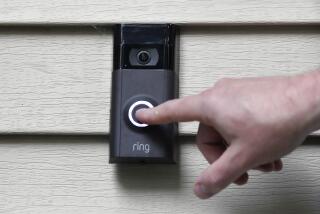Fremont Had It All, Until Web Reality Hit @Home
- Share via
For one wonderful year, Kimberly Paternoster lived in Web-surfer nirvana. A computer programmer and entrepreneur building a business pertaining to Web auctions, she was among the first 100 charter subscribers to @Home--an ultra-high-speed connection to the World Wide Web that operates over cable television lines.
At first the service seemed to fulfill its improbable performance claims--100 times the speed of a standard phone connection to the Web for only $39.95 a month.
Web sites and video clips snapped instantly into view. Paternoster could send large graphics or data files to colleagues in seconds instead of the minutes she was used to with her clunky old modem connection. Best of all, the service was always on. Without the necessity of dialing into a phone line every time she needed it, Paternoster could treat the Internet as the utility it was always forecast to be.
In short, a Web junkie’s dream.
But it didn’t take long for the dream to fade.
“For a year, everything was great. Then suddenly I started experiencing slowdowns at 6 p.m. and on the weekends.”
In November came a worse collapse. For nearly three weeks, subscribers all over Fremont--an affluent Bay Area suburb of about 200,000 residents on the fringe of Silicon Valley--were prevented from logging on for days at a time. When they broke through, Web sites loaded onto their screens with the speed of molasses flowing in a virtual winter. Callers to customer service routinely spent two hours on hold, at which point they were connected with technicians who had no idea how to help.
In sum, Fremont has learned that being a technological pioneer can be something of a mixed curse.
The experience suggests that @Home (now known as Excite@Home) and its partner and largest shareholder, Tele-Communications Inc. (recently acquired by AT&T;), rolled out service to Fremont before it was sure it would “scale”--that is, work as well with 1,000 subscribers as with 100.
“The irony is that since Fremont was where the product was initially rolled out, users here had to endure the most inconveniences,” said Dan Calic, a subscriber who formed a local user group to pressure the service provider and local officials.
Most New Products Harbor Many Bugs
But the experience may be more predictable than ironic.
Many people have learned never to buy a car in its first model year, so defects can be discovered by less-skeptical drivers and corrected by the manufacturer. But at least with automobiles, consumers expect a product that will eventually operate as advertised.
In today’s world of high technology, most new products harbor numerous bugs, sometimes serious enough to destroy their effectiveness. Product life cycles have become so short and the pressure to bring them to market so strong that software developers have long since given up the goal of delivering completely bug-free programs. In a Faustian bargain well-known to experienced computer and Web users, consumers have become used to serving, in effect, as manufacturers’ guinea pigs in order to be first on their block with exciting new features or services.
Microsoft Corp., the biggest software maker, offers the biggest target for such complaints. The company catches plenty of derision for not getting products right until about the third try; that is, after consumers have used two earlier versions and reported hundreds or even thousands of defects. The reason, according to Microsoft programmer Andrew Shuman, writing in a recent edition of the company’s online magazine, Slate, is that Microsoft programmers attempt to satisfy every obscure user need under crushing deadlines.
As Shuman wrote: “If our software is occasionally too fat, we developers fall back on the same excuse philosopher Blaise Pascal offered three centuries ago for his verbose letters: ‘I have only made this [letter] longer because I have not had the time to make it shorter.’ ”
As a community of “early adopters”--that is, well-heeled and technically savvy consumers--Fremont is currently bearing the brunt of guinea-pigdom in the digital communications age. That’s not to say that it bears the burden alone: Severe service problems have also affected other early installations of @Home in Hartford, Conn., and six other Bay Area communities--in which outraged subscribers were awarded three months of free service while technicians conduct a top-to-bottom examination of the network.
Operating under similar pressure to capture market share in high-speed network access, the @Home service in Fremont has been so consistently unreliable that the Fremont City Council has been considering setting minimum service standards--an unprecedented move to regulate Internet service. (The council believes it can do so by virtue of the obligations AT&T; owes as monopoly holder of the local cable TV franchise.)
The city’s initiative is the latest sign that AT&T; cable--accustomed to being the sole provider of the relatively simple medium of cable television--may have underestimated the complexity of delivering Internet services to demanding users.
But the stakes are high. Unlike software companies, which can simply issue upgrades or “patches” to repair bugs in their products, service companies such as AT&T; are coming under a high-powered regulatory microscope.
@Home competitors, chiefly America Online, are using the Fremont problems to underscore their argument that the cable network should be accessible to all Internet service providers, not just those, such as @Home, that are owned by the cable industry.
If a cable subscriber could select Internet service from any provider, not just @Home, they argue, then the threat of competition would ensure that @Home’s service would be nearly faultless--and the City Council would not need to get involved.
Other Telecom Firms Have Chosen Fremont
Fremont appeared to be an ideal showcase for @Home. Many high-tech companies are headquartered there, as are adept users who appreciate the value of broadband Internet service--the “fat pipe” that can rapidly deliver movies, music and large data files. Those qualities have likewise prompted other telecom providers to choose Fremont as an initial site to offer digital subscriber lines, or DSL, a high-speed phone-line-based alternative to @Home.
But unlike a typical subscriber to say, America Online, the city’s technology sophisticates don’t suffer foolish glitches gladly.
“It’s not only incompetence--you can understand that,” said John Bernstein, a retired electrical engineer who worked on high-energy physics projects at the nearby Stanford Linear Accelerator Center. Like many other subscribers, he resents AT&T;’s and @Home’s tendency to blame the victims--explaining any problem as a fault in the subscriber’s computer or on users who improperly tax the system’s resources (“bandwidth hogs”)--rather than the network’s design.
Even after the severe November problem was fixed, however, @Home user bulletin boards continued to chatter with gripes. To this date, the service is still afflicted with intermittent outages and slowdowns during peak hours, when service crawls along at the speed of a standard modem or less.
“These people are idiots,” said Paternoster, exasperated from a recent spate of fruitless tech support calls. “I’ve got 10 friends with cable modems, and nine of us have problems.”
Dan Schoenholz, a Fremont city analyst coordinating a joint AT&T-;@Home user committee to investigate possible service requirements and network design, said that minimum response times for tech support calls and service visits will probably be established in the fall--the first in the nation governing an Internet provider. The vagaries of the Internet make it unlikely that the city will mandate minimum network performance, though that issue is still under consideration.
For their part, AT&T; and @Home executives insist that the service works well for the vast majority of users--quite an accomplishment, they add, given the formidable challenge of managing a subscriber base of about 650,000 that has been doubling every few months and is split among 21 separate cable providers, each of which has different equipment and procedures.
Milo Medin, chief technology officer of Excite@Home, pointed to a recent survey conducted by PC Magazine that awarded @Home high marks for customer satisfaction.
“This is a very complicated service to manage,” Medin said. He acknowledged that such factors as aging equipment can bog down performance and that overloaded Web sites--endemic to the Web and beyond @Home’s control--cannot respond rapidly to user requests.
Users complain, however, that @Home simply hasn’t added network capacity quickly enough to keep up with subscribers, who now number 6,000 in Fremont. Because @Home is a “shared network”--that is, all the users in a given neighborhood are in effect sharing a single large pipeline, much as they might draw their tap water from a single large trunk line--heavy simultaneous use by one or several users in the neighborhood can affect the system’s performance for all.
31,000 Help Calls Are Logged in June
Another system that has become overwhelmed by the growth of the business is @Home’s and AT&T;’s customer service and support. In June alone, 31,000 help calls were logged by @Home, which has nearly 91,000 AT&T; customers nationwide.
All those calls first go to AT&T; service representatives, whose operators try to solve simple problems before referring callers to @Home support personnel. Subscribers said AT&T;’s support has driven many of them to thoughts of tossing the cable modem out the window. While hold times have generally improved from two hours or more to 20-to-60 minutes, the calls often end up as an exercise in futility.
AT&T; cable has struggled to keep up with the volume of support calls. Calls are now answered, on average, within 3 1/2 minutes, according to P.J. Weyforth, a vice president of customer care. The company’s goal, she said, is to answer 90% of calls within 30 seconds--the federal standard for cable TV customer support.
That may not be enough to satisfy the company’s infuriated customers in Fremont.
*
Times staff writer Charles Piller can be reached at charles.piller@latimes.com.
(BEGIN TEXT OF INFOBOX / INFOGRAPHIC)
Products of Imperfection
Excite@Home’s fiasco in Fremont was far from the first case in which the high-tech industry made its customers guinea pigs for imperfect products or services. Here are a few notable potholes on the information superhighway.
1980
Apple III: After reports of malfunctioning equipment show that some chips inside this early personal computer were improperly installed, Apple publicly urges owners to drop the machines onto a flat surface from a height of several inches to ensure its integrated circuits get seated squarely in their sockets. After a few years on the market in the early ‘80s, the machines are recalled and repaired.
*
1994
The Pentium bug: Intel’s heralded Pentium chip reaches the market with a flaw that returns incorrect answers to certain mathematical calculations. After arguing that the flaw would only affect a tiny number of users, Intel bows to public opinion and offers free chip replacements to all who request it--forcing the company to take a $475-million write-off.
Handwriting on the wall for Apple’s Newton: The Newton MessagePad, a precursor of today’s PalmPilot and other palmtops, is launched with software that promises to interpret users’ handwritten scrawls. But the program’s tendency to translate handwriting into gibberish gets memorialized in a series of “Doonesbury” comic strips. The money-losing device is finally taken off the market in 1998.
*
1996
America Online outsmarts itself: Moving to head off rival services offering Internet access at a flat monthly rate, America Online drops its hourly pricing plan and offers unlimited access at about $20 a month. The response is so overwhelming that thousands of users are unable to log on at all, leading to months of embarrassment and investigations by numerous state regulators.
*
1999
The E-Trade outage: A software glitch forces the busy online broker to initiate a series of shutdowns in February. Other online brokerages experience similar problems.
Researched by JENNIFER OLDHAM / Los Angeles Times
More to Read
Inside the business of entertainment
The Wide Shot brings you news, analysis and insights on everything from streaming wars to production — and what it all means for the future.
You may occasionally receive promotional content from the Los Angeles Times.










